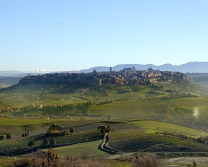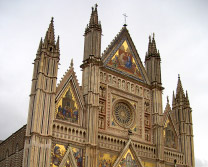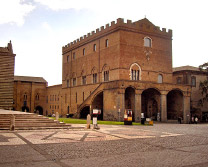B&B Predio San Fernando

Orvieto
Orvieto's origins date back to the 9th-8th century B.C., when Etrurian populations settled on the crag for the first time.
The modern city of Orvieto, indeed, was the Etrurian town of Velzna (Vilsinii in Latin), a city that flourished in the 6th century BC, popular for the production of china (boccaro) and bronze.
Velzna was on the first line against the Roman expansion, and in 254 B.C. it was seized by the enemy and completely destroyed. Its inhabitants left the city in ruins and most of them were forced to move to the hills overlooking the Lake of Bolsena.
During the barbaric invasions, Orvieto was seized by Alarico and Odoacre. Vitige exploited its strategic natural position to make it a defence stronghold in the war against the Byzantines and Belisario conquered it after a long siege in 538 and Totila temporarily seized it again before the final Gothic defeat.
The Longobard leader Agilulfo seized it in 596 and it also started to have its own bishop and in 606, its own counts.
In the 11th century Orvieto became a Commune. Towers and buildings of the aristocracy that moved to the city started to be built.
It became a Guelph stronghold in central Italy against the continuous attacks of the political exiles, the Ghibellines, add the Swabian emperors, Frederic I and Henry IV. In 1199 the first podestà, Pero Parenzo, was appointed by the pope; he was killed soon after in city riots between the opposed factions of the Monaldeschi (Guelphs) and Filippeschi (Ghibellines).
New institutions were created in the 13th century, like the General Council of the 400 (1215), a Captain of the People was elected in 1250, a government of the Senior representatives of the arts with a Prior (1256) and finally the magistracy of the Seven Lords ( 1292) were established, while the intense building activity showed that the city was thriving.
In this period the churches of San Lortenzo degli Arari, San Francesco, San Domenico, Santa Maria dei Servi, the monument of Sant'Agostino were built together with extremely beautiful public buildings, like the Palazzo Comunale, Palazzo del Popolo and Palazzo Papale. In 1290, the construction of the cathedral began.
Between 1281 and 1284 pope Martin IV moved to Orvieto, filling the city with French people, against whom the population arose. When the uprisings started again, the Filippeschi were expelled in August 1313. In 1334 Orvieto was governed by its first Lord, Ermanno Monaldeschi della Cervara until 1337, when he died.
In 1354 Cardinal Albornoz seized Orvieto, subordinating it to the Papal State. The city kept its institutions though, and it became the fifth capital of the fifth province of the Papal State.
In 1860 it was annexed to the Reign of Italy.
In Orvieto very interesting traditional celebrations and cultural events are held almost all over the year.
In spring, among the ancient celebrations, during Pentecost, there is the festival of the stock dove: in Piazza del Duomo the descent of the Holy Ghost is represented with the descent of a symbolic dove (for two days a market with wine and food tasting sessions is held).
Always in Spring, and always among the events of ancient origins, there are the Palio of the Goose, a medieval game of knightly skills, and the celebration of the Corpus Domini, with dances and medieval games held in the centre, together with the procession and the historical parade with three hundred people wearing costumes of the 14th century.
In October, in collaboration with Slow Food, the event “Orvieto with taste”, dedicated to food culture, is organized.
Between Christmas and New Years' Eve, there are the concerts of the Umbria Jazz Winter.



